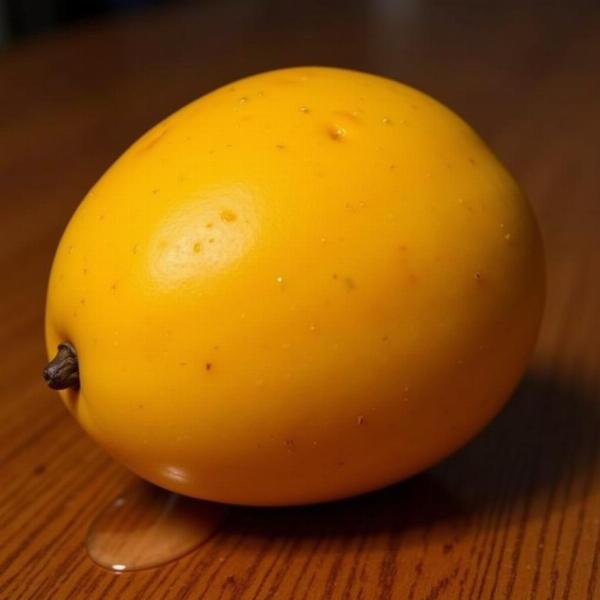Understanding the meaning of “ripe” in Hindi is essential for anyone navigating Indian markets, recipes, or simply everyday conversations. “Ripe” indicates a fruit or vegetable has reached its peak maturity, offering optimal flavor, texture, and nutritional value. This concept is deeply ingrained in Indian culture, where fresh, seasonal produce plays a vital role in cuisine and traditions. But how do we express this crucial concept in Hindi? Let’s explore the nuances and various translations of “ripe” in the Hindi language.
Different Ways to Say “Ripe” in Hindi
Hindi offers a rich vocabulary to describe ripeness, with variations based on context, region, and the specific fruit or vegetable. Here’s a breakdown of the most common terms:
- Pakka (पक्का): This is the most common and versatile term for “ripe.” It’s widely understood and applicable to most fruits and vegetables. For example, you might say “pakka aam” (पक्का आम) for a ripe mango or “pakki sabzi” (पक्की सब्ज़ी) for ripe vegetables.
- Pukht (पुख़्त): While similar to “pakka,” “pukht” emphasizes the completeness of the ripening process. It implies the fruit or vegetable is fully developed and ready to eat.
- Taiyar (तैयार): Meaning “ready,” “taiyar” can be used in the context of ripeness, particularly when asking if a fruit is ready to eat. “Kya aam taiyar hai?” (क्या आम तैयार है?) – “Is the mango ready?”
- Raseela (रसीला): This term emphasizes the juiciness associated with ripeness, often used for fruits like mangoes, watermelons, and oranges. “Raseela phal” (रसीला फल) means a juicy, ripe fruit.
 Ripe Mango
Ripe Mango
Regional Variations and Specific Terms
Beyond these common terms, various regions and dialects use specific words to denote ripeness. In some parts of North India, “pola” (पोला) is used for ripe melons, while “billa” (बिल्ला) can indicate a ripe guava. These regional nuances enrich the language and reflect the diverse culinary traditions across India.
How to Tell if a Fruit is Ripe
Knowing the Hindi words for “ripe” is just the beginning. Here’s a practical guide to assessing ripeness:
- Color: Look for the characteristic color of the ripe fruit, such as a deep yellow for mangoes or a bright red for tomatoes.
- Texture: Ripe fruits generally yield slightly to gentle pressure, indicating softness and juiciness.
- Aroma: A sweet, fragrant aroma is often a telltale sign of ripeness.
Ripe Fruits in Indian Cuisine
Ripe fruits are integral to Indian gastronomy, featuring in everything from chutneys and pickles to desserts and beverages. The sweetness of ripe mangoes enhances the flavor of “aam ras” (mango pulp), while the tanginess of ripe tamarind adds depth to “imli chutney” (tamarind chutney).
What is your favorite ripe fruit and how do you enjoy it?
Dr. Anjali Sharma, a renowned food historian, emphasizes the significance of ripe fruits in Indian cuisine: “The concept of ripeness is not merely about taste; it’s about harnessing the fruit’s full nutritional potential and celebrating the bounty of nature.”
Why is Understanding Ripeness Important?
Beyond culinary applications, understanding ripeness contributes to cultural understanding and effective communication in India. Whether you’re buying groceries, discussing recipes, or simply enjoying a conversation, knowing the appropriate Hindi terms for “ripe” demonstrates respect and facilitates connection.
Conclusion
From “pakka” to “raseela,” Hindi offers a diverse vocabulary to describe ripeness. Understanding these nuances is key to navigating Indian culture and enjoying the delicious array of fruits and vegetables this country offers. So, next time you’re at the market, confidently ask for “pakka phal” (ripe fruit) and savor the flavors of India!
FAQ
- What is the most common Hindi word for ripe? Pakka (पक्का) is the most widely used term.
- What does “raseela” mean? “Raseela” (रसीला) emphasizes the juiciness of a ripe fruit.
- How can I tell if a mango is ripe? Look for a deep yellow color, a slightly soft texture, and a sweet aroma.
- Why is understanding ripeness important in India? It’s crucial for navigating markets, understanding recipes, and connecting with Indian culture.
- Are there regional variations in Hindi words for ripe? Yes, different regions may use specific terms like “pola” or “billa” for certain fruits.
- What are some popular Indian dishes made with ripe fruits? “Aam ras” (mango pulp), “imli chutney” (tamarind chutney), and various fruit salads are popular examples.
- Where can I find more information about Hindi translations? Check out resources like Meaning-Hindi.in for accurate and reliable translations.
Related Articles
Meaning-Hindi.in is your one-stop solution for all your Hindi translation needs. We offer a comprehensive range of services, including business and commercial document translation, legal and certified translation, technical and user manual translation, website and localization translation, educational and academic document translation, express translation, and specialized industry translation. Our expert linguists ensure accuracy and cultural sensitivity in every project. Contact us today for a free quote at [email protected] or call us at +91 11-4502-7584. Meaning-Hindi.in is dedicated to bridging language barriers and fostering effective communication.